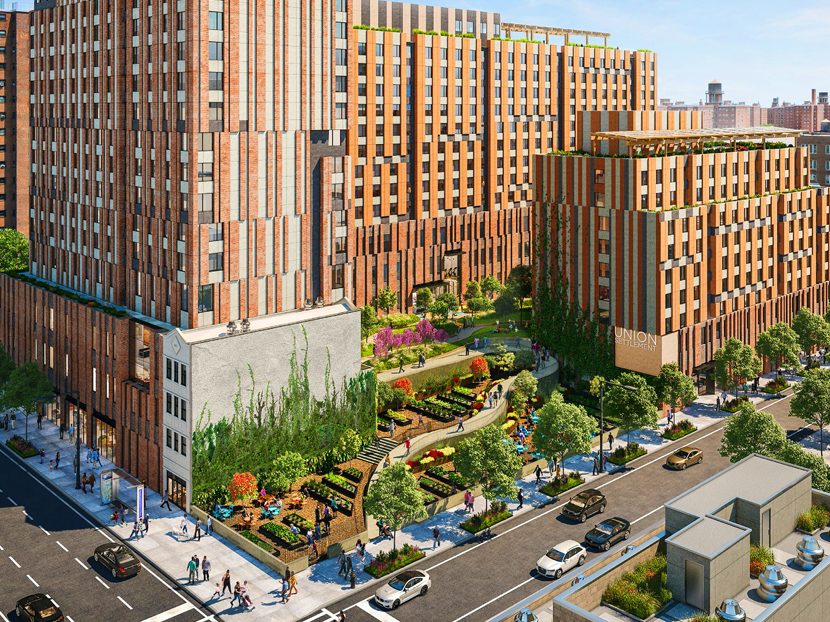Modern Community Models
Reducing carbon footprints and increasing resiliency.

If you’ve read this space in the past, you’ll know that I often write about projects. My last two columns have, instead, reviewed the critical modern technologies shaping our 2010s and 2020s built environment. It’s time to return to some actual projects.
Read on for information on three modern community models based on a few ideas which are old but coming-of-age. These include an extensive VRF-based multi-unit residential project in Harlem; a low-carbon new neighborhood in New Hampshire that will be integrated with a modern approach to agriculture; and a growing number of college and other campuses looking at the multiple benefits of microgrids and islanding.
Harlem’s Sendero Verde
An 812,250-square-foot complex in Harlem, N.Y., Sendero Verde includes 674 units of affordable housing, along with community facilities and some commercial space.
Mechanical systems include a high-performance, low-energy variable refrigerant flow (VRF) system with floor-mounted air handlers in each of the one-, two- and three-bedroom apartments, and split-style wall-mounted units in the studio units.
Each floor is served by the equivalent of one condenser, meaning that each condenser does one-third of a level, multiplied by three stories. This is because different zones face the sun in different ways, involving different gain conditions. Affordable housing budgets usually don’t include VRFs with heat recovery.
The condensers on each floor are thermally isolated because the project is targeting passive house certification. This means they are located in cubicles that are essentially outdoors, although with a grill on one side and enclosed on three sides. A Ceco Trio-E insulated door with a thermally broken frame permits access to the unit.
“We used refrigerated warehouse doors on a previous project, then discovered the Ceco product,” said Lois Arena, director of Passive House services at Steven Winter Associates, who designed Sendero Verde and many other New York passive house systems.
Rooftop energy recovery ventilators provide apartment ventilation, with the goal being to balance exhaust and supply ventilation within 10 percent of one another and, of course, retain as much heating or cooling energy as possible.
The passive house requires an overall source energy maximum of 120 kilowatts per square meter each year (38,100 BTUs/ft2/year). Heating can be 15 kilowatts per square meter a year (4,750 BTUs/ft2/year). Cooling in the New York area can be 17 kilowatts per square meter per year (5,390 BTUs/ft2/year).
In addition, New York is among the most brutal places to plan a new building if you like carbon fuel systems. New laws are regulating them out of new buildings and are even requiring thousands of building renovations before 2024. Fines for noncompliance are significant.
“This building and most of the passive house projects already meet the 2030 New York carbon cap,” Arena said. “The walls are R30. We’ve been paying a lot of attention to thermal bridges and perforations.”
Arena and her team are also helping the city develop modern low-carbon building models for different building sizes or ages, which can be taught to others.
Air changes/hour through the facade can be no more than 0.6 at 50 pascals of pressure, which is five to 10 times tighter than a typical building. It means the Sendero Verde walls will be insulated continuously and carefully sealed for an R-value of 30, the roof for R-40, and the double-pane windows will provide U values of 0.149 (operable) and 0.134 (fixed).
Affordable Clean Energy Buildings
I’ve been writing about clean energy building systems, clean water systems and natural refrigerants for nearly two decades. In the early years, editors were afraid to publish the information. They would ask: “Does it work? Can anyone afford it? Has anyone measured the emissions? Can the industry learn to install this technology?”
The HVAC industry, in general, thought the only viable “clean” building system was a high-efficiency gas furnace. They were told the heat pumps so prevalent in Europe and Asia would never work in the cold weather in North America. When someone said clean energy would cost more but the premium would be recovered quickly, many only repeated the first half of that sentence.
Some still think the best way to protect their businesses is to stick with fossil fuels, but the fact is, the economics argument is now louder than the chants of the climate activists in the streets. The affordable clean-energy housing project at Sendero Verde is being built for less than 5 percent more than a non-passive house building and will save 50 percent to 60 percent on operating costs. That’s what’s known as a disruptive value equation. Nothing can defeat that.
Portland, Ore.’s Orenco Station, Distillery North in Boston, Onion Flats in Pennsylvania, Ontario’s Blossom Park and dozens of others — they’re all passive house affordable projects built for about the same cost as conventional affordable housing. As one professional said recently, “It’s not rocket science; we’ve just finally decided to put up better buildings.”
About 2,000 passive house projects exist in North America, and by the time you read this paragraph, there will probably be 2,001. The increasingly popular model is attracting droves of builders and municipal planners to conferences and webinars on the subject. In November, Arena presented Sendero Verde and three other New York projects at the Passive House Canada Conference in Toronto.
Arena says New York has recently invested a great deal of money in competitions won by 18 different modern architecture and engineering teams. The initiative has helped reveal successful low-carbon projects as case studies and other training tools for developers, architects, designers, engineers and inspectors.
Developers also are attempting to use the passive house model in the retrofitting of old affordable housing structures. Early returns suggest it will be successful, revealing a viable solution for more than 100,000 such 1970s and 1980s buildings with mechanicals and interiors that are at the end of their useful lives and need replacing.
Agrihoods
When I first heard about Carter Scott’s agrihood in New Hampshire, I thought it was a throwback to the 1960s communes full of long-haired hippies wearing Birkenstocks. But Scott usually is future-oriented. He was among the first builders to create homes in freezing-cold Massachusetts with small enough heating loads to hit net-zero and still have enough energy left for an electric car, with just 10 kilowatts of solar photovoltaics.
In the days after he told me about the agrihood, I read about looming agriculture and water crises around the world, about indoor agriculture operations with fabulous yields, less soil or no soil and limited chemicals, some of them stacked like apartment buildings in dense urban locations. I sighed through reports of dogs dying, blue algae-clogged waterways all across America and another summer of worrying we will never swim again in many of our lakes.
I checked the market progress of organic consumer products and the decline in popularity of golf courses, sometimes the key feature in a new subdivision. And then there is the localization of, well, everything. Agrihoods started to sound very modern.
The Jacobson Farm Net Positive Agrihood in Amhearst, N.H., will consist of 64 homes meeting all five of the passive house criteria, plus a modern organic farm.
“It’s community-supported agriculture,” Scott said, “which means each season people pre-purchase all their organically grown vegetables for the year.”
The buildings will cover about 20 percent of the 126-acre site. The farm will be partly indoor and partly old-style farming, meaning avoidance of the monocropping habit, natural processes, low or no tilling, compost, biochar, silvopasture livestock and chickens.
“We’re looking at the natural ways to build up carbon in the soil that don’t involve a lot of pesticides or chemical fertilizers,” Scott explained. “They don’t help the land over the life of the farm. You end up with dead zones like the one at the end of the Mississippi. The runoff takes the oxygen out of the water.”
The homes will be mostly two-bedroom single-family houses or attached homes and will be equipped with air-source heat pumps, heat pump water heaters and energy recovery ventilators.
“If they do cost more to build, the utility savings will take care of that in less than five years,” Scott said.
The community will also see some tiny homes, cottage-style structures, a microgrid, including a solar farm, and lithium-ion electricity storage. Scott said there has been minimal difficulty attracting prospective buyers.
“Some people are relocating to New Hampshire just because they get to live in an agrihoods,” Scott noted.
Campus Islands
Clever microgrid entrepreneurs are currently meeting with universities all over America and offering to install free batteries and software. At Soka University in California, a software company called Stem installed 400 kilowatts of batteries without asking the school for any money upfront. In exchange, Soka signed a 10-year deal to lease the system. In the first year, the university made a net profit of $55,000 after lease costs. Again, a disruptive no-brainer value equation. But that’s not the end of the story.
Back in 2012, when Superstorm Sandy hit New York and New Jersey, two microgrid communities were able to offer emergency electric power and shelter. Princeton University was equipped with some solar, combined heat and power, thermal storage and backup diesel generators. A residential community in New York called Co-op City had a similar system.
These islands of resilience during a significant disaster have caught the attention of university and corporate campus facility planners far and wide. In addition, governments struggling with cybersecurity threats and emergency planning have taken note. In times ahead, the microgrids are less likely to involve diesel or even biomass, and more likely to integrate clean renewables and batteries, or thermal storage.
They appeal to governments, corporations and institutions because they can quickly switch to off-grid, offline, no-fuel systems and continue operating, completely self-contained. America’s future is a series of networked micro-grid, largely electrified systems that can instantly disconnect from the wider system, lock-down as self-sufficient protective islands, and welcome the public inside or selectively invite individuals, depending on the situation.
“The logical progression in communities is to further reduce carbon and to increase resiliency,” Scott said.
Arena agreed, “Back in the day when passive house was developed, they could see we were heading toward a crisis with the climate. So, the Germans did calculations to determine how a building would have to be designed in order to stop contributing to global warming. Now we’re building that way.”





